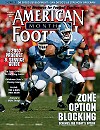AMERICAN FOOTBALL MONTHLY THE #1 RESOURCE FOR FOOTBALL COACHES
Article CategoriesAFM Magazine
|
Lobo Cover 2New Mexico\'s corner and safety techniquesby: Troy Reffett © More from this issue Our base defensive alignment is a 3-3-5 that allows us to execute multiple blitzes and coverages from various fronts. One of the primary coverages we have in our package is Cover 2. We will run Cover 2 with three, four and five man pressures. Based on the amount of pressure, the underneath drops and assignments may vary slightly. The one position that remains constant in their assignments and techniques is the cornerbacks. I will focus on our coaching progression with the corners in depth and talk briefly about our safeties assignments. Base Corner Rules and Reminders: • Collision – Funnel – Sink • Alignment at five yards or less – Press • Formation – Quick 2 • Vision – Through #1 to #2 and QB We want the words Collision – Funnel – Sink – to immediately come to mind when Cover 2 i....The full article can only be seen by subscribers. Subscribe today!
|
|
|||||||
| HOME |
MAGAZINE |
SUBSCRIBE | ONLINE COLUMNISTS | COACHING VIDEOS |
Copyright 2025, AmericanFootballMonthly.com
All Rights Reserved





